The principle of operation of fans of various modifications
Today, in almost any home you can find a fan of different designs. Exhaust system in the kitchen, air conditioners, coolers in the PC, the forced ventilation system of different rooms in the home and at work - all these devices can not function properly without this important component. In this article we will get acquainted with the principle of operation of fans of different design, as well as learn their advantages and disadvantages.
Axial or axial
In appearance, this type of fan is a metal casing in the form of a cylinder, where the wheel with blades of different configurations is located, mounted on a single shaft with a drive. The case has special perforations for secure fastening at the place of use. Air flow enters parallel to the axis of rotation. At the entrance is a collector - it improves the aerodynamics of the product in the process. How the product works can be explained quite simply.
- The electric motor mounted on a special frame spins the impeller of the fan, mounted on one shaft with it.
- The impeller speed is identical to that specified by the manufacturer.
- The blades are fixed on the hub in such a way as to capture the layers of air and guide them along the axis. Blade sweep it has no clear gradations: in everyday life it is used several centimeters long, and in industry it is up to several meters.
The device is protected by a fine mesh, which eliminates the ingress of objects that can harm the structure, and in order to ensure safety.
The efficiency of axial assemblies is significantly higher than other products, the pressure of the air mass and its quantity can be adjusted by changing the angle of attack of the blades. This type of fan is used to move very large air masses with low counter resistance.
Below is a drawing of an axial fan, where 1 is a case; 2 - impeller; 3 - scapulae; 4 - electric motor.

Advantages:
- relatively low power consumption;
- the mechanism works properly without human intervention;
- installation does not require much space.
Disadvantages:
- the product works properly only with air without impurities;
- high vibration and noise accordingly.
As a rule, such products are installed outside the objects so that the fan operation noise does not interfere with the production process.
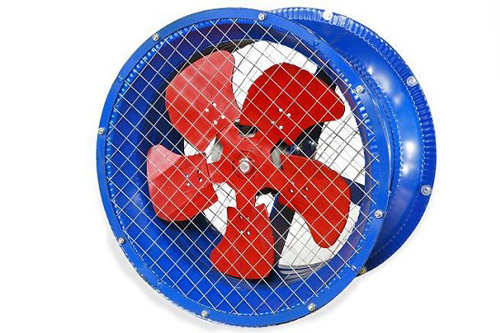
Radial
Radial or centrifugal device is different from other types of unusual spiral housing designin which the impeller is located, compressing the air masses during rotation, moving them in the direction from the center to the peripheral part. In the casing flow enters under the influence of centrifugal forces from the rotation of the wheel with blades.
The blades are welded to the hollow cylinder along its entire perimeter strictly parallel to the axis of rotation using steel discs, their ends are bent in or out, which depends on the direct purpose of the device. Rotation can be done in any direction - it depends on how the fan is arranged, and what tasks are assigned to it (discharge or exhaust).
The main components of the radial fan are shown in the drawing below, where 1 is the case; 2 - impeller; 3 - impeller blades; 4 - fan axis; 5 - bed; 6 - the engine; 7 - exhaust pipe; 8 - flange of the suction inlet
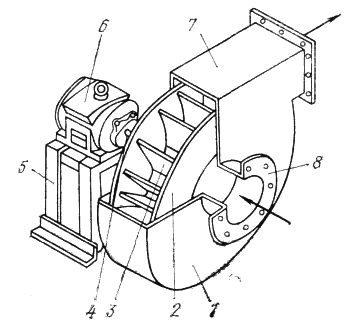
Pros:
- maintains decent overloads;
- energy savings of up to 20%;
- small diameter of the impeller;
- low speeds of rotation of a shaft of the drive.
Minuses:
- high vibrations and noise;
- demands on the quality of the manufacture of rotating parts.
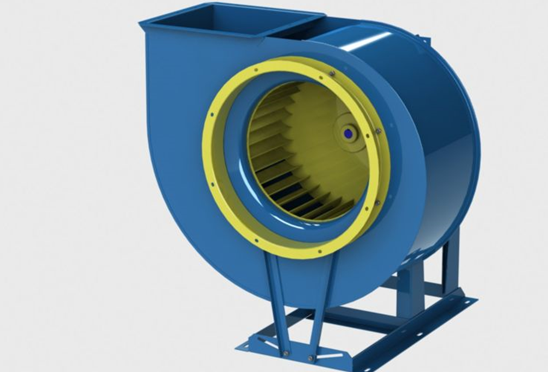
Channel
This type of fan is installed in the walland only its grille is visible in the room, then air ducts go through which the exhaust air is directed outside or to the filtration and cleaning system, after which it returns.
To find out all the nuances of the fan of this type, watch the video. It explains in detail the functional features of the duct fan.
For the manufacture of cases of these original devices used layered canvasconsisting of steel, durable plastic or combinations thereof. The connection is made by spot welding or fasteners.
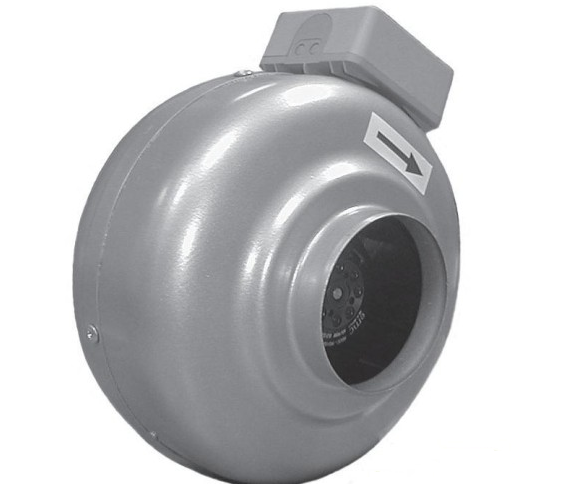
Advantages:
- processing at the same time several rooms;
- add fresh air from the street;
- variations in air flow.
Minuses:
- when serving in all rooms, mixing takes place; if someone smokes, this smell gets into other rooms;
- no independent temperature control;
- high cost of installation, which includes the price of pipelines;
- to clean the filters, you need a hatch for work.
On a note! Very high performance on the operation of such fans because of their original structure make them popular. Channel fans are installed in homes, large shopping malls and in some types of production.
Tangential
Products of this type consist of a body having a diffuser and a pipe, the original form of an impeller, very similar to the header of a combine harvester, only greatly reduced in size with forward-curved parallel blades.
The principle of operation of the tangential fan is based on the re-passage of air through the working parallel blades in the transverse direction, which is the original nuance of this design. In addition, these devices are quite high in terms of aerodynamics.
Below is a simplified drawing of a tangential fan, where 1 is the inlet, 2 is the impeller, 3 is the output diffuser.

Due to the fact that they can create a flat flow of air masses, they are often used for “warm closures”, having the rotation shaft in a vertical position.
Benefits:
- very high efficiency;
- the ability to direct the flow in any direction;
- creating a uniquely flat and uniform airflow.
This type of product has a very low noise level with a rather large air flow per unit of time.

Bladeless
The principle of operation is based on the operation of a flapless fan. jet engine: there is a turbine, whose work contributes to the rapid air circulation in the room The design of this fan is very original: a powerful base, an oval working part, visually very similar to the air intake of a modern aircraft engine.
The contour ring has a number of perforations through which air is pulled out, dragging layers of air masses according to the law of aerodynamics.A powerful turbine can pump up to 20 cubic meters of air per second, which similar devices cannot - this is the main difference of this type of product.
The speed of the air passing through the ring can reach quite decent values, the manufacturers of such original equipment claim that it can exceed 90 km / h.
Positive traits:
- speed of assembly and installation;
- high security;
- big savings;
- remote control;
- LED-backlight, successfully replaces the night light;
- the drive brushes are made of a magnetic alloy, which eliminates the accumulation of dust on them;
- very unusual design.
Minuses:
- high price;
- strong noise effect due to high flow rate.
Such original products are considered a type of floor fan.
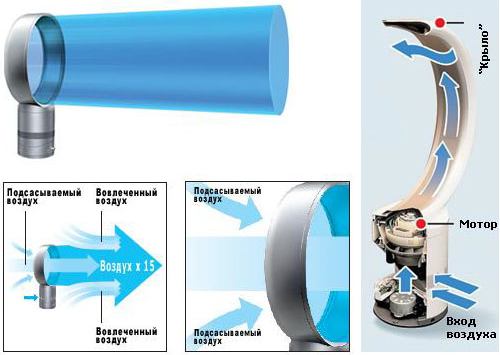
Household
For the implementation of normal ventilation in the apartment or in your own home use a special design of household fans, because they must work efficiently and not let the backdraft into the room along with all negative components.
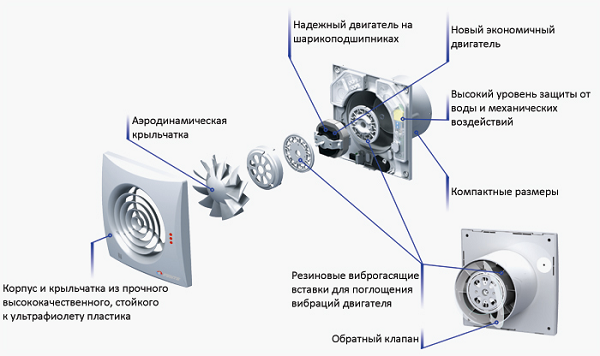
The electrical circuit of the fan differs depending on its type and purpose - it is attached to the product instruction manual.The analogous wiring diagram of the connection practically does not change, with the exception of some specific nuances for each specific device.

Domestic fans are also understood as the structures familiar to all of us for cooling indoor air. By performance they may be table or floor viewStandard equipment - electric drive, impeller and safety grilles.
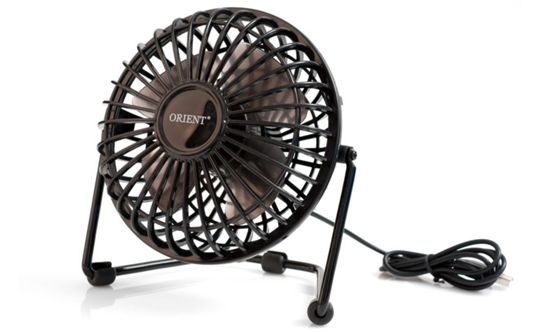
The functions of the domestic fan can be expanded through effective additions:
- air humidification;
- ionization system, which is very useful for the younger generation and the elderly.
These improvements increase the cost of the product, but they have a positive effect on the microclimate of the room, especially in the period of a surge in seasonal diseases.
Pros:
- easy operation and installation;
- quite versatile;
- low cost.
Can not use:
- with bronchial asthma;
- in case of oncological diseases;
- if there is a lot of dust in the room;
- when there is intolerance to ionization.

/rating_off.png)











